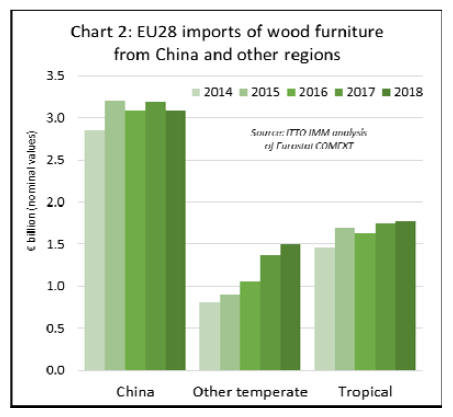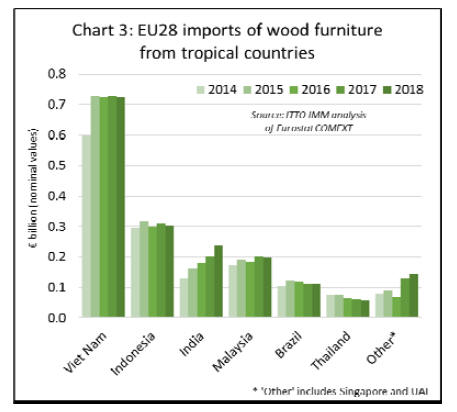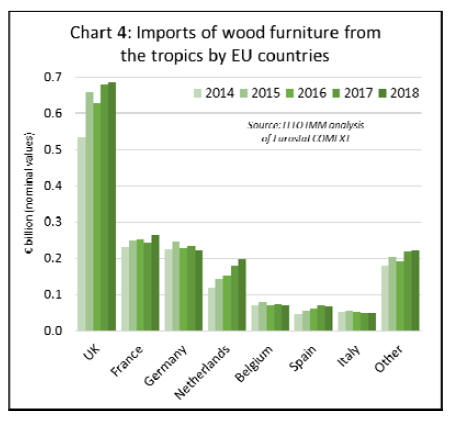|
Report from
Europe
Sharp slowdown in EU wood furniture trade at
the end
of 2018
After a strong start to the year, the trade in wood furniture
slowed sharply in the last quarter of 2018. EU imports of
wood furniture from outside the region, which were up 6%
in the first nine months of 2018, finished the year down
around half a percentage point compared to 2017 at €6.36
billion. This is a reversal of the slow recovery in EU
imports that began in 2013. (Chart 1).

The decline in wood furniture imports closely mirrors
changes in the wider European economy.
According to the EU Winter 2019 Economic Forecast
published in February, economic activity in the EU cooled
in the second half of 2018 as political tensions and
uncertainty over fiscal policy and Brexit sapped business
and consumer confidence and output in some Member
States.
GDP growth in both the euro area and the EU slipped to
1.9% in 2018, down from 2.4% in 2017. Slowing
economic growth fed through into a fall in the value of the
euro and the British pound, both of which weakened
against the U.S. dollar by around 8% during 2018.
These changing economic conditions are also indicated by
a slowdown in internal EU wood furniture trade which,
after hitting a peak of €22.1 billion in 2017, fell back
nearly 7% in 2018 to €21.8 billion. The Brexit situation
led to a slowing in UK imports both from within and
outside the EU in the second half of 2018, while broader
concerns about the EU economy contributed to a slowdown
in trade elsewhere in the region.
The decline last year interrupts a long-term sharply rising
trend in internal EU trade on-going since the financial
crises in 2008-2009.
This long-term trend has been driven by increased market
integration within the EU, the shift in manufacturing from
higher cost countries in the western EU to lower cost
eastern locations, particularly Poland, and the growing
presence and influence of large-scale retailing chains
operating at cross country level, most notably IKEA. More
wood furniture imports into the EU from outside the
region are also now being funneled via the Netherlands.
The drive towards greater integration of the EU furniture
market and access to relatively lower cost manufacturing
locations in the eastern EU partly explains the continuing
dominance of EU-based manufacturers in the region.
ITTO¡¯s own estimates based on analysis of Eurostat data
indicate that EU-based manufacturers account for around
85% of all wood furniture sold in the region.
In recent years, European manufacturers have boosted
productivity and competitiveness through investment in
more advanced computer-controlled and automated
manufacturing, cutting overheads and reducing the relative
labour cost advantages of overseas producers.
There¡¯s been a particularly large investment by Western
European furniture manufacturers in Eastern European
countries, notably since their accession into the EU from
2004, and this is now maturing. From being principally
production satellites for large western European brands,
Eastern European manufacturers are now developing their
own identity and market momentum.
Furniture manufacturers in the EU area are also making a
virtue of their shorter supply chains which not only reduce
transport costs but also allow products to be delivered
more rapidly.
External suppliers face other more direct challenges to
expanding sales in the EU. Despite some recent
consolidation, there is still a relatively high degree of
fragmentation in the retailing sector in many European
countries which complicates market access. Many
overseas suppliers remain reliant on agents and lack direct
access to information on fashions and other market trends.
The progressive migration of European furniture sales
online is also tending to favour local manufacturers better
placed to meet the short lead times demanded by internet
retailers and consumers.
EU furniture manufacturers losing export market share
European furniture manufacturers are also strongly
motivated to maintain and increase share in their home
markets as they are now struggling to expand sales outside
the EU. Last year there was a 1.7% fall in the value of EU
wood furniture exports to €8.78 billion.
This continues a trend of flat-lining, or slowly declining
exports to countries outside the EU after reaching an alltime
high of just over €9 billion in 2015. Since then the
competitive benefits of the relative weakness of the euro
against the dollar and other cost saving efforts of EU wood
furniture manufacturers have waned.
Competition for EU-based manufacturers has intensified
from newly emerging producers in Eastern European
countries outside the EU, such as Bosnia, Ukraine and
Turkey, and from Vietnam which in the last 5 years has
rapidly overtaken all other tropical countries in the global
league table of wood furniture producing nations.
EU wood furniture manufacturers have suffered in higherend
export markets in Asia, the CIS and Middle East from
a range of factors including cooling of the Chinese
economy, a sharp fall in global equity markets towards the
end of 2018, extreme weakness of the Russian rouble,
relatively low oil prices and political instability.
Given domestic market problems in the EU and the
European Central Bank¡¯s policy to keep interest rates at
record-lows to boost demand, the euro is expected to
depreciate against the dollar in 2019, which may boost EU
exports a little this year.
However, while the risk of outright global recession in
2019 still seems low, a general global deceleration is
widely forecast with growth falling below potential in
most regions. Overall therefore, EU wood furniture
exports are unlikely to rise significantly this year.
Challenging market for external suppliers to the EU
Prospects for non-EU wood furniture suppliers selling into
the EU are mixed. All suppliers face an uphill struggle to
compete with EU domestic manufacturers.
Added to this challenge this year is the economic
uncertainty inside the EU and the prospects for further
weakening of European currencies against the US dollar.
Gains are being made by some external suppliers, but
nearly all are in countries neighbouring the EU. Only one
tropical wood furniture supplier, India, is currently making
ground in the EU market.
After a brief upturn in 2017, EU wood furniture imports
from China, by far the largest external supplier, fell 3% to
€3.09 billion in 2018. China¡¯s competitiveness in the EU
wood furniture market has been impeded as prices have
risen on the back of growing domestic demand and new
laws for pollution control pollution in China.
In 2018, EU imports of wood furniture continued to rise
from other temperate countries, mainly bordering the EU.
EU imports from these countries increased 9% to €1.49
billion in 2018, building on a 28% gain recorded the
previous year. The biggest gains in 2018 were made by
Ukraine, Belarus, Russia, USA, Bosnia, and Turkey.
After a slow start to the year, EU imports of wood
furniture from tropical countries picked up pace a little in
the second half, and were €1.78 billion overall for 2018,
up 2% compared to the previous year (Chart 2).

The main South East Asian supply countries have all
followed a similar trajectory in the EU wood furniture
market in the last two years. A rise in EU imports in 2017
was followed by a decline in 2018.
After increasing 1% to €728 million in 2017, EU imports
from Viet Nam fell 0.5% to €724 million in 2018. Imports
from Indonesia increased 4% to €311 million in 2017 but
fell back 2% to €304 million in 2018. Imports from
Malaysia increased 10% to €203 million in 2017 and were
2% down at €199 million last year.
In contrast, EU wood furniture imports from India
continued to rise, up 18% to €239 million in 2018 after a
12% increase to €202 million in 2017. Imports from Brazil
were €113 million in 2018, matching the 2017 level (Chart
3).

There were also shifts in the destinations for wood
furniture imported into the EU from tropical countries in
2018. Imports in the UK, the largest market, were €687
million last year, 1% more than in 2017. There were also
rising imports in France (+9% to €264 million) and
Netherlands (+9% to €198 million).
However, these gains in 2018 were offset by falling
imports of tropical wood furniture in Germany (-6% to
€220 million), Belgium (-2% to €72 million), Spain (-4%
to €67 million), and Italy (-1% to €50 million) (Chart 4).

Brexit saga damages prospects for market expansion
The UK¡¯s dominant position in the EU as by far the
leading destination for wood furniture imports from
tropical countries, suggests that the on-going Brexit saga
may have significant long-term effects.
While there may be long term benefits for external
suppliers resulting from the UK¡¯s decision to pull back
from deeper EU integration, these benefits seem to be a
very distant prospect. At present, the uncertainty is
significantly undermining prospects for market growth in
the short to medium term.
UK economic growth in 2018 was only 1.4%, down from
1.8% in 2017 and the joint worst year (with 2012) since
the financial crisis.
According to the latest UK government summary of
independent forecasts, UK growth is expected to be
around 1.3% in 2019 and even this is dependent on the UK
resolving the Brexit issue one way or the other.
Even now that the official Brexit date of 29th March 2019
has passed, the full economic and political fallout of the
UK¡¯s vote to depart the EU are very hard to predict.
With the UK government asking the EU for a delay until
such time as serious internal political differences can be
resolved, there is still uncertainty over the timing of
Brexit, or whether the UK will depart on terms agreed
with the EU or, failing that, there is a ¡°disorderly exit¡±
with attendant severe economic disruption. It is still
possible the UK changes course entirely and decides to
remain in the EU.
Overall the indications are that the UK market for wood
furniture, after making some small gains last year, will
contract in 2019.
Europe¡¯s role in the global furniture trade
Despite recent deterioration in the EU¡¯s balance of
furniture trade, European manufacturers remain a major
force in the international furniture sector. Their dominance
of the EU¡¯s internal wood furniture market is also unlikely
to be seriously challenged in the foreseeable future.
This is made clear in a series of detailed reports on
Europe¡¯s place in the global furniture sector newly
released by the Italy-based research organisation CSIL.
More details of the reports ¡°The Fumiture Industry in
Europe¡±, 'World Furniture Outlook 2019' and 'Forecast
Report on the Furniture Sector in Italy, 2019- 2021' are
available from www.worldfurnitureonline.com or by email
csil@csilmilano.com).
CSIL estimate the total value of global furniture trade in
2018 was around US$149 billion, 4% up on the previous
year and building on a 6% increase in 2017. CSIL expect
the world furniture trade to continue to grow by 4% in
2019.
CSIL reckon world furniture consumption was US$460
billion in 2018 (production prices excluding the markup
for distribution). World furniture consumption is forecast
by CSIL to rise around 3.2% in real terms this year with
growth concentrated in Asia and Pacific.
In the EU, CSIL estimate that total furniture production
continued to grow in 2018, rising between 1% and 2% in
real terms. According to CSIL forecasts, this rate of
growth should continue until at least 2020.
The CSIL global ranking of 100 countries identifies
Germany, the UK and France as the main importing
countries worldwide after the United States (although at a
distance). Germany, Italy and Poland are the main
exporting countries at a global level, after China (at a
distance).
CSIL highlight that while Asia has become more dominant
in the global furniture sector, Europe remains the second
largest furniture manufacturing region in the world and
still accounts for around one quarter of global furniture
production.
Europe is also the headquarters of some of the largest and
most important sector players (around one third of the top
200 largest furniture companies in the world are located
here).
Europe accounts for roughly one quarter of the global
world furniture market. Per capita furniture consumption
is the highest in the world (alongside North America).
Europe accounts for around 44% of world furniture
imports and 41% of world furniture exports.
CSIL points out that the EU furniture sector now employs
around one million workers, many of which are highly
skilled, in 121,500 manufacturing firms, mainly micro and
small sized. This, together with a rich cultural heritage,
gives European manufacturers a competitive edge and
promotes the development of creative competences which
are recognized worldwide.
CSIL note that ¡°the European industry is able to combine
new technologies and innovation with cultural heritage,
tradition and style, providing jobs for skilled workers and
is also a world leader in the high-end segment of the
furniture market¡±.
CSIL suggest that in addition to the barriers created by a
large and highly competitive domestic industry, there are
other obstacles to non-EU producers entering the market,
including logistical costs and requirements for various
forms of certification to specific technical and
environmental standards.
|